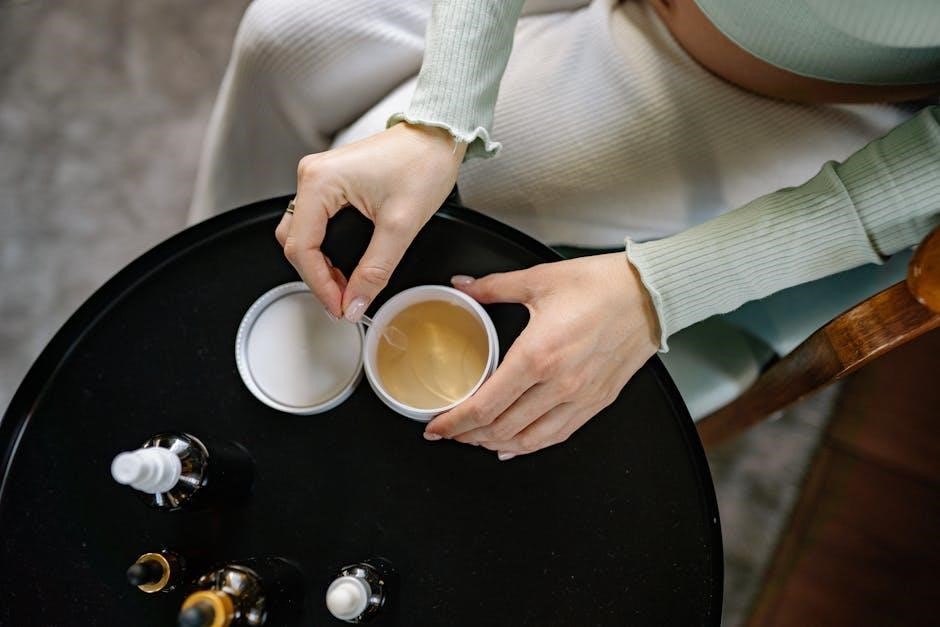mam bottle self steriliser instructions
The MAM Bottle Self-Steriliser offers a convenient, microwave-powered solution for sterilizing baby bottles. Designed for portability, it simplifies hygiene maintenance during travel and daily use, ensuring safety and efficiency.
What is a Self-Sterilising Bottle?
A self-sterilising bottle, like the MAM Easy Start Anti-Colic Bottle, is designed for simple and effective sterilization using a microwave. This innovative design eliminates the need for a separate steriliser, making it ideal for travel and daily use. The bottle can be sterilised in just a few minutes by exposing it to steam in the microwave, ensuring all parts are thoroughly cleaned and free from germs. This feature provides parents with a convenient and hygienic way to maintain their baby’s feeding essentials, promoting safety and peace of mind. The self-sterilising function is a key advantage of MAM bottles, offering a practical solution for busy families.
Key Features of MAM Self-Sterilising Bottles
MAM self-sterilising bottles are designed with convenience and safety in mind. One of their standout features is the ability to sterilise directly in the microwave without needing a separate steriliser, making them ideal for travel and daily use. The bottles disassemble into six separate parts, ensuring thorough cleaning and sterilisation. They are also equipped with anti-colic technology, reducing air bubbles and promoting easier feeding for babies. The self-sterilising function is effective at killing germs and bacteria, providing a hygienic solution for parents. Additionally, MAM bottles are BPA-free, ensuring safety for infants. These features make MAM self-sterilising bottles a practical and reliable choice for families seeking efficient and portable baby care solutions.
Preparing for Sterilisation
Before sterilising, ensure all bottle parts are disassembled and thoroughly rinsed. This step is crucial for effective sterilisation and maintaining your baby’s safety and hygiene.
Disassembling the Bottle
Disassembling the MAM bottle is essential for effective sterilisation. Start by removing the lid, teat, and collar, then separate the body, base, and valve; Ensure each part is clean and free from residue before proceeding. This step ensures all components are properly exposed during sterilisation. The MAM self-sterilising bottles are designed to be easily taken apart, making the process straightforward. Once disassembled, place all parts in the steriliser, ensuring they are arranged to allow steam to circulate evenly. Proper disassembly is crucial for maintaining hygiene and ensuring the sterilisation process is effective. Always refer to the manufacturer’s guidelines for specific disassembly instructions to avoid any potential damage to the bottle parts.
Rinsing the Bottle Parts
Rinsing the disassembled bottle parts is a critical step before sterilisation. After disassembling, each component, including the teat, collar, body, base, valve, and lid, should be thoroughly rinsed under cold running water. This ensures the removal of any visible residue, milk particles, or debris. Use a soft-bristle brush to gently scrub areas like the teat and valve, where milk can accumulate. Avoid using hot water during rinsing, as it may cause warping or damage to the plastic parts. Once rinsed, shake off excess water to prevent pooling, which could lead to uneven sterilisation. Proper rinsing ensures that the sterilisation process is effective and that no residue remains on the bottle parts. This step is essential for maintaining hygiene and ensuring the bottle is safe for your baby to use.

Microwave Sterilisation Process
The MAM Bottle Self-Steriliser uses microwave steam to kill germs and bacteria. Place disassembled parts with 30ml water, heat for 3-5 minutes, then let cool.
Step-by-Step Instructions for Microwave Sterilisation
To sterilize MAM bottles in the microwave, start by disassembling the bottle into its six parts: lid, teat, collar, body, base, and valve. Rinse all components under clean running water to remove any visible residue. Next, place the parts into a microwave-safe sterilizer, ensuring they are arranged properly. Add 30ml of clean water to the sterilizer. Set the microwave timer for 3-5 minutes, depending on your microwave’s power level, and begin the sterilization process. After the cycle completes, allow the sterilizer to cool for a few minutes before removing it from the microwave. Carefully take out the basket and let the water drain. Finally, let the sterilized parts air dry on a clean surface before reassembling and using the bottle.
Recommended Sterilisation Time
The recommended sterilisation time for MAM self-sterilising bottles in the microwave is typically between 3 to 5 minutes, depending on the microwave’s power level. It’s essential to follow the manufacturer’s guidelines to ensure effective sterilisation without damaging the bottle components. Overheating can warp plastic parts, while insufficient time may not kill all germs. For optimal results, set the timer according to the microwave’s wattage: 3 minutes for higher-powered microwaves (1000 watts and above) and 5 minutes for lower-powered ones (below 1000 watts). Always allow the sterilizer to cool for a few minutes after the cycle completes to avoid burns when handling. Proper timing ensures the bottles are safe and ready for your baby to use. Regularly check for any damage post-sterilisation to maintain hygiene and safety standards.

Benefits of Self-Sterilising Bottles
MAM self-sterilising bottles offer unmatched convenience, ideal for travel and daily use. They simplify hygiene maintenance, ensuring bottles are always clean and ready for your baby on the go.
Convenience for Travel and Daily Use
MAM self-sterilising bottles are designed for ultimate convenience, making them perfect for travel and daily use. Their microwave sterilisation feature eliminates the need for bulky sterilisers, allowing parents to easily clean and prepare bottles on the go. Whether you’re at home, visiting family, or exploring new places, these bottles provide a hassle-free solution. The lightweight and compact design ensures they fit effortlessly into travel bags. For daily routines, the quick 3-5 minute sterilisation process saves valuable time, making it ideal for busy parents. The ability to self-sterilise without additional equipment ensures your baby always has a clean, safe bottle ready, no matter where life takes you. This feature is a game-changer for maintaining hygiene and convenience in any situation.
Effectiveness in Killing Germs and Bacteria
MAM self-sterilising bottles are proven to be highly effective in eliminating common household germs and bacteria. The microwave sterilisation process uses steam to thoroughly sanitise all bottle components, ensuring a 99.9% reduction in harmful microorganisms. This method is both reliable and efficient, providing parents with peace of mind knowing their baby’s feeding equipment is clean and safe. The self-sterilising feature is particularly beneficial for newborns and young infants, whose immune systems are still developing. By following the recommended sterilisation time of 3-5 minutes, parents can trust that their bottles are free from contaminants. This effectiveness makes MAM self-sterilising bottles a top choice for maintaining the health and safety of babies, especially during the crucial early stages of their development.

Common Mistakes to Avoid
Common mistakes include not checking for damage after sterilisation and overheating the bottles, which can compromise safety. Always inspect and follow time guidelines for optimal results.
Improper Disassembly of Bottle Parts
One common mistake is failing to properly disassemble the bottle into its six separate components: lid, teat, collar, body, base, and valve. If not done correctly, some parts may not be fully exposed to steam during sterilisation, leading to incomplete germ elimination. This can result in residual bacteria, potentially harming your baby’s health. Always ensure each piece is separated and arranged correctly in the steriliser. Neglecting this step can compromise the effectiveness of the sterilisation process, leaving harmful microorganisms behind. Proper disassembly is crucial for ensuring all parts are thoroughly cleaned and sterilised. Always double-check that all components are accounted for and correctly placed before proceeding with the sterilisation process.
Using Incorrect Water Levels
Using the wrong amount of water in the steriliser is a common oversight. Too little water may fail to generate enough steam for proper sterilisation, while excessive water can lead to hot spots or uneven heating. Both scenarios can result in incomplete sterilisation, potentially leaving harmful bacteria behind. Always follow the manufacturer’s guidelines for the correct water level to ensure effective steam circulation. Incorrect water levels can also cause the bottle parts to become misshapen or damaged due to uneven heat distribution. To avoid this, measure the water carefully before adding it to the steriliser. Proper water levels are essential for maintaining the integrity and safety of the bottles and their components. This simple step ensures optimal sterilisation and prevents potential damage to the bottle parts.

Troubleshooting Tips
Address issues like residual odors by rinsing thoroughly after sterilisation. Inspect bottles for damage, such as warping or cracks, and replace if necessary to ensure safety and effectiveness.
Dealing with Residual Odors
Residual odors after sterilisation can occur due to improper drying or lingering moisture. To address this, thoroughly rinse all bottle parts with clean water and ensure they air dry completely. If odors persist, mix a mild detergent with warm water and soak the parts before rinsing. Avoid using harsh chemicals, as they may discolour or damage the materials. For persistent issues, repeat the sterilisation process or allow the bottles to air dry for an extended period. Regular maintenance and proper storage can help prevent odors from forming. Always inspect for visible residue and repeat cleaning if necessary. This ensures your baby’s bottles remain fresh and safe for use.
Checking for Damage Post-Sterilisation
After sterilising your MAM bottle, it’s crucial to inspect for any signs of damage. Look for cracks, warping, or discoloration, especially around the teat and valve areas. Check for loose parts or separations in the joints, as high heat can sometimes weaken adhesives. Ensure no water spots or mineral deposits are present, as these can harbour bacteria. If any damage is detected, discontinue use and replace the affected parts. Regularly checking for damage ensures the bottle remains safe and functional for your baby. Neglecting this step could lead to leaks or contamination, compromising the sterilisation process. Always follow the manufacturer’s guidelines for inspecting and maintaining your MAM self-sterilising bottles.
The MAM Bottle Self-Steriliser offers a practical solution for parents seeking convenience and hygiene, ensuring safety and efficiency in baby care routines with minimal effort required.
Final Thoughts on MAM Self-Sterilising Bottles
The MAM Self-Sterilising Bottles are a game-changer for parents, offering unparalleled convenience and hygiene. Their innovative design allows for easy sterilization in a microwave, making them perfect for travel and daily use. The bottles are durable, safe, and designed with baby’s comfort in mind, ensuring a seamless feeding experience. Parents can trust the self-sterilising feature to effectively kill germs and bacteria, providing peace of mind. These bottles are a must-have for any parent seeking practical, efficient, and reliable baby care solutions. Their portability and ease of use make them ideal for busy lifestyles, while their effectiveness ensures a healthy environment for babies. Overall, MAM Self-Sterilising Bottles are a excellent choice for modern parenting.
Recommended Maintenance for Long-Term Use
Regular maintenance is crucial to ensure the longevity and effectiveness of MAM Self-Sterilising Bottles. After each use, thoroughly rinse all parts with clean water to prevent milk residue buildup. Avoid using abrasive cleaners or scrubbers, as they may damage the bottle’s surface. For optimal hygiene, sterilize the bottles daily, either by boiling or using the microwave feature. Additionally, check for any signs of wear or damage, such as cracks or torn teats, and replace them promptly. Store the bottles in a dry, clean place to prevent bacterial growth. By following these maintenance tips, parents can ensure their MAM bottles remain in excellent condition, providing safe and reliable use for their babies over time.